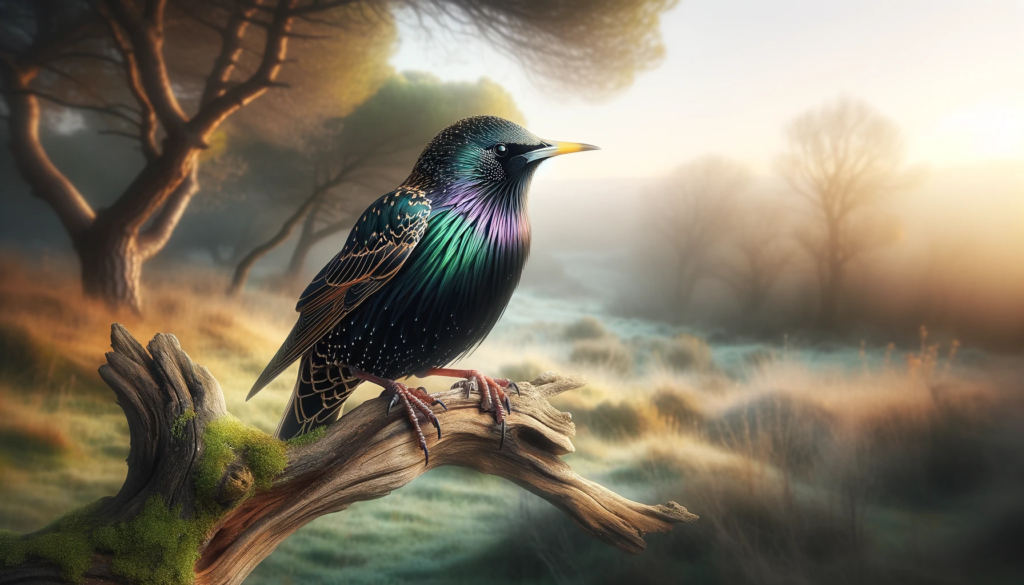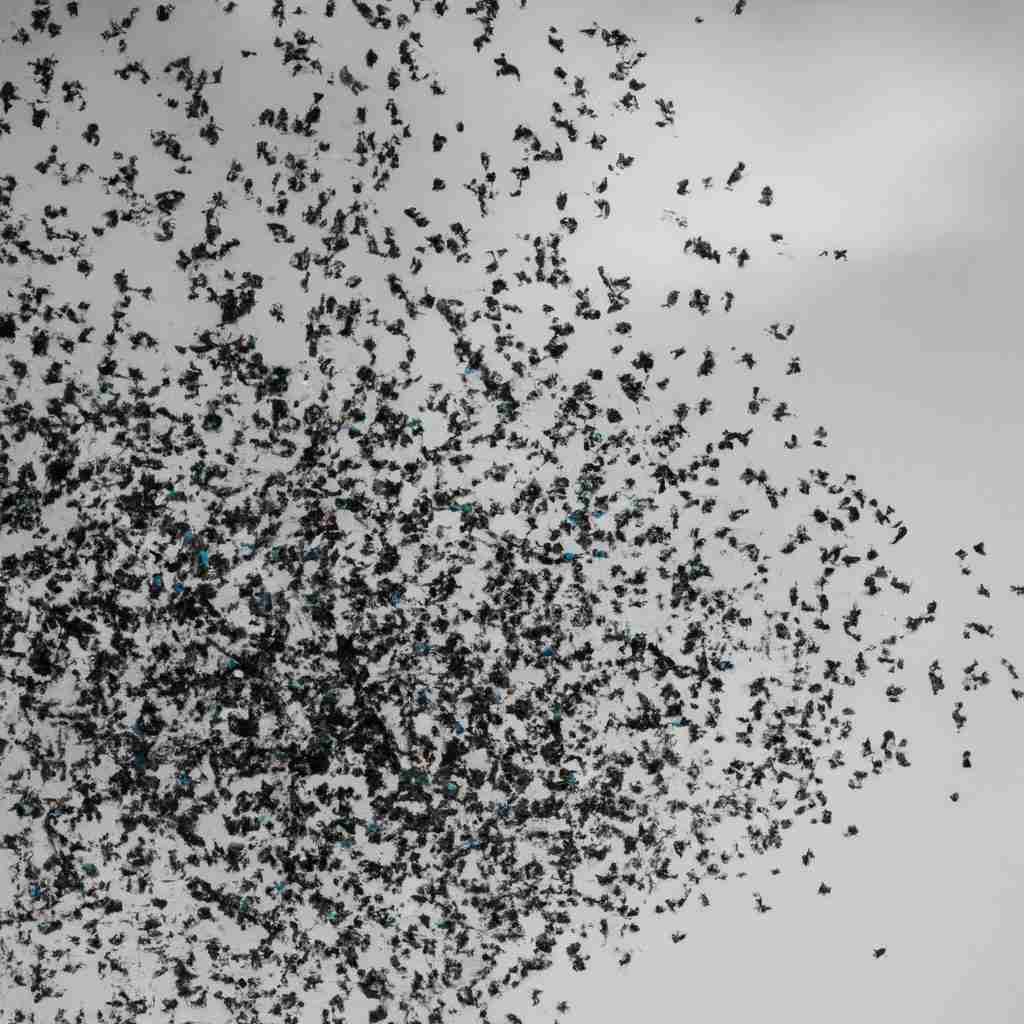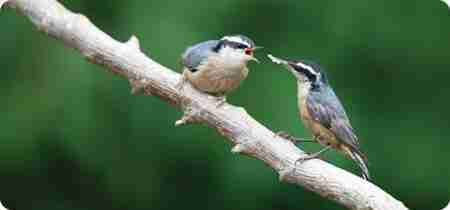Imagine a mesmerizing scene in the sky, where thousands of starlings weave and whiz, moving as one in perfect harmony. This captivating sight, known as the Flock of Starlings, is not just a mere spectacle but a remarkable survival strategy.
These birds join forces to fend off predators like diving falcons, who possess incredible speed and agility. By forming flocks, starlings reduce their chances of being caught, and with constant movement and effective communication, they enhance their survival rates even further.
The synchronized flight patterns of starlings create a stunning spectacle that confuses and deters falcons, allowing for safer and more efficient flight. In this article, we will explore the strategies employed by these birds to avoid diving falcons and delve into the fascinating world of their synchronized movements.
Formation of Flock of Starlings
Safety in Numbers
Flock formation is a common behavior observed in starlings where thousands of birds come together and showcase synchronized movements. One of the primary reasons for starlings to form flocks is safety in numbers. By staying together in a large group, starlings significantly reduce the chances of being attacked by predators, especially diving falcons. Predators are less likely to target a large group of birds compared to a single starling flying alone. Therefore, flocking provides a sense of security for individual starlings, making it harder for predators to single out and successfully capture a member of the flock.
Reducing Predator Attacks
Another significant advantage of flock formation is the reduced risk of falling victim to predator attacks, particularly from diving falcons. Falcons are widely known for their impressive hunting skills and agility. They have evolved to be fierce apex predators, utilizing various techniques to catch their prey. However, when it comes to hunting starlings, their task becomes significantly more challenging due to the synchronized movements and coordinated behavior of the flock. The sheer number of starlings flying together creates a visual spectacle that confuses and disorients the diving falcons, making it harder for them to target and capture individual birds. This collective defense strategy is advantageous for starlings as it greatly enhances their chances of survival against their formidable predators.
Characteristics of Falcons
Fierce Hunting Skills
Falcons are renowned for their fierce hunting skills. They have evolved to be exceptional predators, constantly honing their hunting techniques to ensure successful captures. Falcons possess a set of characteristics and abilities that contribute to their prowess as hunters.
Excellent Eyesight
One of the falcon’s most notable attributes is its excellent eyesight. It is said that a falcon can spot its prey from great distances, thanks to its highly developed visual acuity. This keen eyesight allows falcons to detect small movements and pinpoint potential targets even amidst a large flock of starlings.
Rapid Speed
Falcons are incredibly fast birds, capable of reaching astonishing speeds in flight. They are known for their swift and powerful wings, allowing them to accelerate rapidly and close the distance between themselves and their prey within seconds. This speed is a crucial weapon in their hunting arsenal, as it enables them to surprise their targets and launch swift attacks.
Agile Flight
In addition to their speed, falcons display agile flight capabilities. They are capable of making sharp turns, sudden dives, and rapid changes in direction mid-flight. This agility allows them to navigate through complicated aerial terrains, making it difficult for their prey to escape.
Sharp Talons
Falcons possess strong and sharp talons that are perfectly adapted for capturing and gripping their prey. These talons are their primary tools for securing a firm hold on their victims during a hunt, ensuring that the prey does not escape their grasp.
Powerful Beak
Another important feature of falcons is their powerful beak. The beak is used not only for tearing into the flesh of their captured prey but also for delivering precise and lethal strikes during an attack. The robust beak of a falcon allows them to swiftly dispatch their prey, ensuring a quick and efficient kill.
Strong Wings
The wings of a falcon are incredibly strong and well-suited for swift and sustained flight. The powerful strokes of its wings enable the falcon to maintain speed, maneuver through the air effortlessly, and execute intricate aerial maneuvers while in pursuit of its prey.
Predatory Instincts
Falcons possess highly developed predatory instincts that aid them in their hunting endeavors. These instincts include an acute awareness of their surroundings, exceptional focus, and the ability to identify vulnerabilities in their prey’s behavior or flight patterns.
Skilled Aerial Maneuvers
Just like starlings utilize synchronized movements to confuse predators, falcons showcase their own set of skilled aerial maneuvers during hunts. These maneuvers include high-speed dives, sudden turns, and acrobatic flight patterns. By employing these techniques, falcons are able to surprise their prey, making it harder for the starlings to evade capture.

Hunting Techniques of Falcons
High-speed Dives
One of the most impressive hunting techniques of falcons is the high-speed dive. Falcons are capable of reaching remarkable speeds during their descent, often diving vertically towards their prey. This strategy allows them to close in on their target rapidly, leaving little time for the prey to react or escape.
Visual Target Acquisition
Falcons rely heavily on their excellent eyesight to acquire and lock onto their targets visually. Their exceptional vision enables them to spot movement from great distances, identify potential prey, and track their movements with precision. This visual target acquisition is essential for the success of their hunting endeavors.
Prey Pursuit
Once a falcon has identified its target, it initiates a chase, pursuing its prey with unmatched speed and agility. The falcon’s rapid flight allows it to close the distance quickly, keeping up with the movements of the starlings in the flock.
Aerial Acrobatics
During a hunt, falcons display impressive aerial acrobatics. They maneuver through the air with grace and dexterity, executing sudden turns, rolls, and twists to maintain pursuit. These aerial acrobatics make it more challenging for starlings to predict the falcon’s movements and escape successfully.
Strike and Capture
Once the falcon has closed the distance and successfully positioned itself close to its prey, it employs a swift and precise strike. Using its powerful beak and sharp talons, the falcon captures its prey with speed and accuracy, ensuring a secure grip that prevents escape.
Swift Retreat
After capturing its prey, the falcon swiftly retreats to a safe location to consume its meal. This retreat is driven by the falcon’s instinct to protect its catch from potential theft by other predators or scavengers in the area.
Importance of Flock Formation for Starlings
Safety
One of the primary reasons starlings form flocks is to ensure their safety. By staying together in large numbers, starlings reduce the chances of being singled out and attacked by predators. The collective behavior and sheer numbers of the flock make it harder for predators to target and capture individual starlings, increasing their overall survival chances.
Finding Food
Flock formation also aids starlings in finding food more efficiently. By flying together, starlings share information about food sources within their range. If one starling discovers a plentiful feeding site, it can quickly communicate this information to the rest of the flock, leading to a collective benefit. The shared knowledge within the flock allows them to locate food resources more effectively and maximize their foraging efforts.
Social Interaction
Flocking provides starlings with opportunities for social interaction. Within the flock, starlings communicate with each other through vocalizations and visual signals. These interactions foster social bonds and allow individuals to learn from one another. The presence of the flock provides starlings with a sense of belonging and community, which is crucial for their mental well-being.
Thermoregulation
Flock formation also aids in thermoregulation, especially during colder months. By huddling together in close proximity, starlings conserve body heat and keep each other warm. The collective body heat generated within the flock helps to maintain a more favorable temperature, particularly during cold nights or inclement weather conditions. This communal thermoregulation enables starlings to withstand harsh environmental conditions more effectively.
Migration
Migration is another important aspect of starling behavior, and flock formation plays a significant role in this process. When starlings migrate, they often travel long distances, and flying in a cohesive flock provides several advantages. By flying together, starlings reduce aerodynamic drag, conserve energy, and benefit from the navigational knowledge of the group. The collective effort allows the flock to cover greater distances more efficiently, facilitating successful migration.

Swarm Behavior of Starlings
Definition and Explanation
Swarm behavior refers to the continuous movement and coordinated actions exhibited by starlings within a flock. It is a mesmerizing phenomenon where thousands of birds navigate through the sky, seemingly as a single organism. This synchronized movement is driven by the complex interactions between individual starlings within the flock.
Continuous Movement within the Flock
One of the defining characteristics of swarm behavior is the continuous movement of starlings within the flock. The starlings maintain an intricate pattern of flight, constantly adjusting their positions relative to each other. This movement creates a dynamic and ever-changing formation, making it harder for predators such as diving falcons to target an individual bird.
Effect on Diving Falcons
The continuous movement within the flock has a significant impact on diving falcons. The synchronized movements and rapid changes in direction confuse and disorient the falcon, making it challenging for them to lock onto a single target. This confusion reduces the likelihood of the falcon successfully capturing a starling and enhances the overall survival chances of the flock.
Murmuration in Flock of Starlings
Definition and Explanation
Murmuration is a specific type of coordinated movement within a flock of starlings. It involves the rapid and synchronized turning and twisting of the birds in flight, resulting in a mesmerizing display of collective motion. Murmurations often occur during the evening or twilight hours and are a visually stunning spectacle.
Avoiding Diving Falcons
Murmuration plays a crucial role in avoiding diving falcons. The rapid and synchronized movements of starlings within a murmuration create a visual spectacle that confuses and disorients the falcons. The unpredictable and chaotic nature of the swirling flock makes it incredibly challenging for the falcon to single out a target and execute a successful attack. Murmurations, therefore, serve as a defense mechanism to deter diving falcons.
Enhanced Survival Chances
The collective behavior exhibited during murmurations significantly enhances the survival chances of starlings. The captivating display of movement not only confuses predators but also showcases the strength and unity of the flock. This unity reinforces the concept of safety in numbers, making it less likely for individual starlings to fall victim to the attacks of diving falcons. Murmurations provide starlings with a collective defense strategy, increasing their overall chances of survival.

Communication within the Flock
Visual Signals
Visual signals play a crucial role in communication within the flock. Starlings employ various physical cues and movements to convey information to other group members. These visual signals can include wing flapping, head tilts, beak gestures, and body positioning. These signals aid in coordinating the movements of the flock, keeping individuals in sync and facilitating the formation of mesmerizing patterns.
Vocalizations
Vocalizations are an essential form of communication within the flock. Starlings produce a wide array of vocalizations, ranging from short chirps and calls to more complex melodies. These vocalizations serve multiple purposes, including signaling the presence of danger, sharing information about food sources, and maintaining cohesion within the flock. By vocalizing, starlings can effectively communicate vital information to members of the flock and ensure collective awareness.
Importance for Survival
Effective communication within the flock is crucial for the survival of individual starlings. By exchanging information through visual signals and vocalizations, starlings can alert each other to potential threats, coordinate their movements during flight, and share knowledge about available resources. This seamless communication ensures that the flock remains cohesive and can respond appropriately to external stimuli, ultimately enhancing their chances of survival.
Strategies to Avoid Diving Falcons
Swarm Behavior
One of the main strategies employed by starlings to avoid diving falcons is swarm behavior. By continually moving as a cohesive unit, the starlings create a visual spectacle that makes it difficult for the falcons to target an individual bird. The synchronized movements and constant changes in flight patterns confuse and disorient the falcons, reducing their chances of successful attacks. Swarm behavior provides a collective defense mechanism that enhances the overall survival chances of the flock.
Murmuration
Murmuration is another powerful strategy utilized by starlings to avoid diving falcons. The rapid and synchronized twisting and turning of the birds within the flock creates a captivating display that disorients and confuses the falcons. The unpredictable nature of murmurations makes it challenging for the falcons to accurately forecast the movements of individual starlings, further reducing their success rate in capturing prey. Murmurations serve as a visually stunning defense mechanism, effectively deterring diving falcons.
Synchronized Flight Patterns
Starlings also employ synchronized flight patterns to avoid diving falcons. By flying together in precise formations and maintaining a cohesive group structure, starlings create a visual spectacle that disorients and confuses the falcons. The synchronized flight patterns serve as a powerful deterrent, making it harder for the falcons to single out a target and execute a successful attack.
Visual Spectacle
The visual spectacle created by swarm behavior, murmurations, and synchronized flight patterns is a key strategy utilized by starlings to avoid diving falcons. The chaotic and mesmerizing movements of the flock disorient and confuse the falcons, decreasing their success rate in capturing individual starlings. The overwhelming visual display acts as a deterrent and enhances the overall chances of survival for the starlings.
Disorienting Falcons
All of the aforementioned strategies employed by starlings serve to disorient diving falcons. The continuous movement within the flock, combined with the synchronized flight patterns and chaotic murmurations, challenge the falcons’ ability to track and target individual starlings. By disorienting the diving falcons, starlings increase their chances of evading capture and ensure their continued survival.

Increasing Chances of Survival
Successful Avoidance of Diving Falcons
One of the critical factors that contribute to the chances of survival for starlings is successfully avoiding diving falcons. By utilizing strategies such as swarm behavior, murmurations, and synchronized flight patterns, starlings minimize the risk of being captured by their formidable predators. These collective defense mechanisms enhance the overall survival rates of the flock, as the falcons’ success in capturing individual starlings decreases significantly.
Efficient Flight
By flying together in a coordinated manner, starlings increase their overall flight efficiency. The synchronous movements and precise flight patterns allow the flock to navigate through the air with minimal resistance, reducing aerodynamic drag. This efficient flight conserves energy and allows starlings to cover longer distances while minimizing fatigue.
Strength in Numbers
The formation of flocks provides starlings with strength in numbers, increasing their chances of survival. When diving falcons encounter a large flock of starlings, they are faced with an overwhelming number of potential targets. The sheer size of the flock makes it challenging for the falcons to single out and successfully capture an individual starling. The collective presence of the flock acts as a strong deterrent, discouraging diving falcons from initiating an attack.
Enhanced Protection
The synchronized movements and coordinated behavior within the flock provide starlings with enhanced protection. By staying close to one another, starlings create a physical barrier that makes it harder for predators to access and capture individuals. The proximity of the flock members acts as a form of collective defense, decreasing the vulnerability of each starling and increasing their overall chances of survival.
Benefits of Synchronized Flight Patterns
Visual Spectacle
One of the major benefits of synchronized flight patterns in starlings is the creation of a visually spectacular display. The coordinated movements and precise flight patterns result in mesmerizing patterns and shapes in the sky. This visual spectacle often attracts the attention of humans and serves as a source of awe and wonder.
Confusing Diving Falcons
Synchronized flight patterns serve as a strategic advantage for starlings by confusing and disorienting diving falcons. The precise formation and coordination of movements within the flock make it challenging for the falcons to track and target individual starlings. The visual complexity created by synchronized flight patterns further reduces the success rate of diving falcons in capturing prey.
Survival Enhancement
The mesmerizing synchronized flight patterns significantly enhance the survival chances of starlings. By flying together in coordinated formations, starlings reduce their individual vulnerability to predator attacks. The visual spectacle created by the synchronized flight patterns acts as a deterrent, discouraging diving falcons from initiating an attack. The survival enhancement provided by these flight patterns contributes to the overall success and longevity of the starling flock.
In conclusion, the formation of a flock of starlings is a remarkable phenomenon driven by the instinct for safety in numbers and the collective strategies to reduce predator attacks. Falcons, known for their fierce hunting skills and agility, pose a significant threat to individual starlings. However, through swarm behavior, murmurations, and synchronized flight patterns, starlings employ effective tactics to confuse, disorient, and displace diving falcons. These strategies, along with efficient communication and the strength of the flock, increase the chances of survival for starlings. By harnessing the power of collective movement, starlings demonstrate the remarkable interplay between individual actions and cooperative behaviors, showcasing the strength and resilience of nature’s intricate ecosystems.




Pingback: Exploring Sparrow Habitats Across the Globe